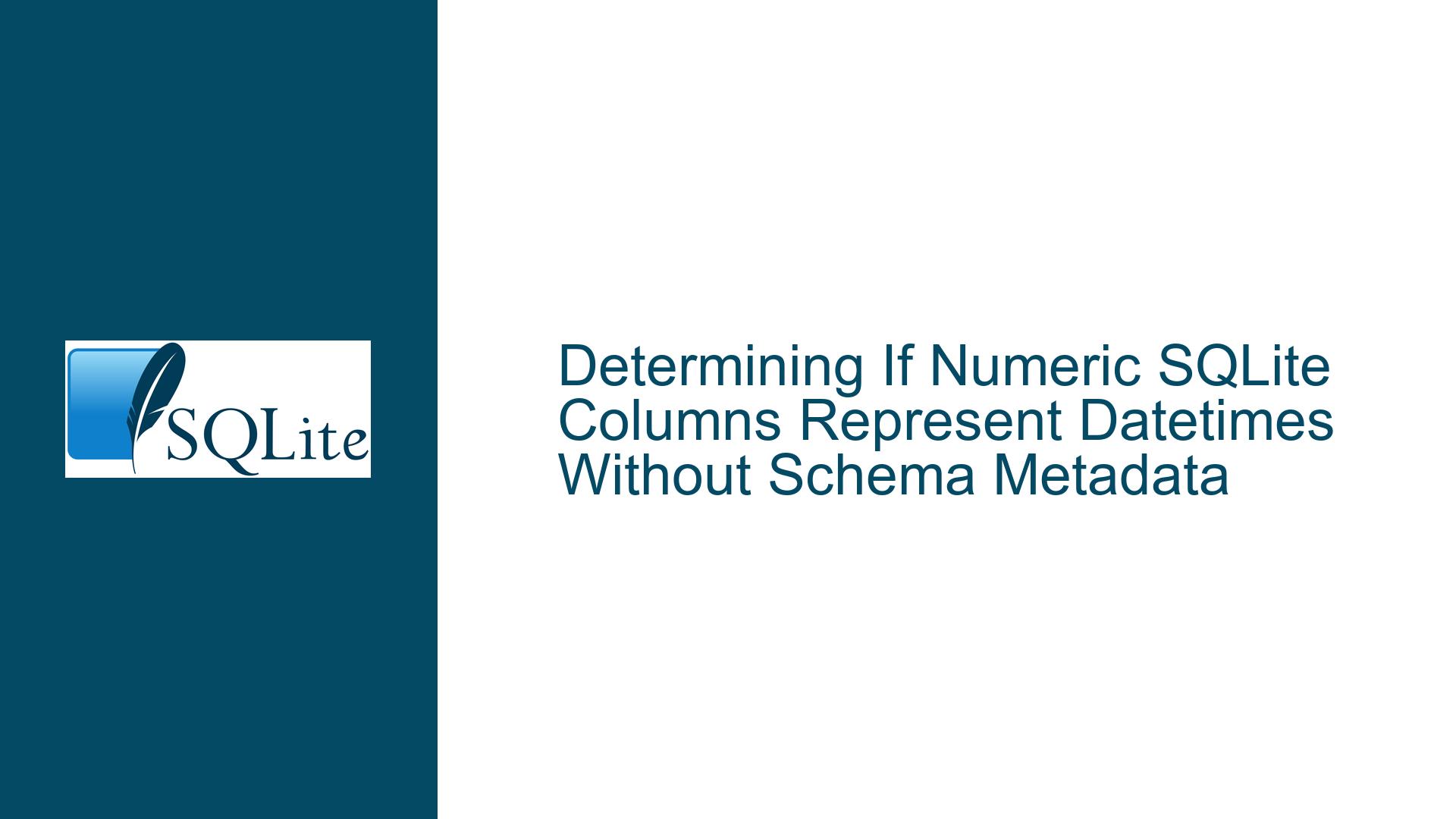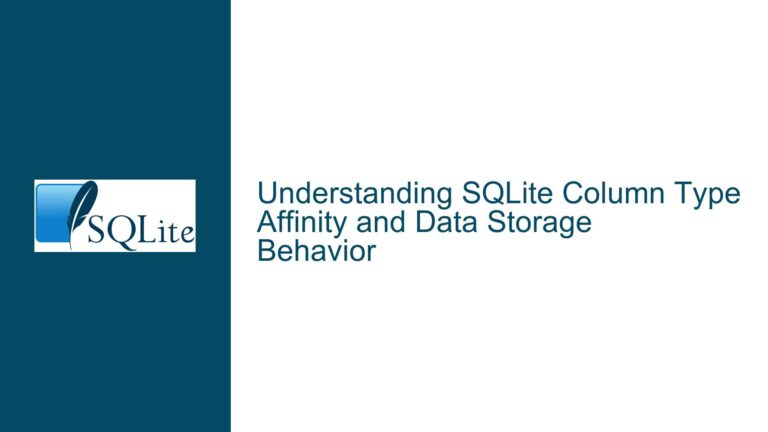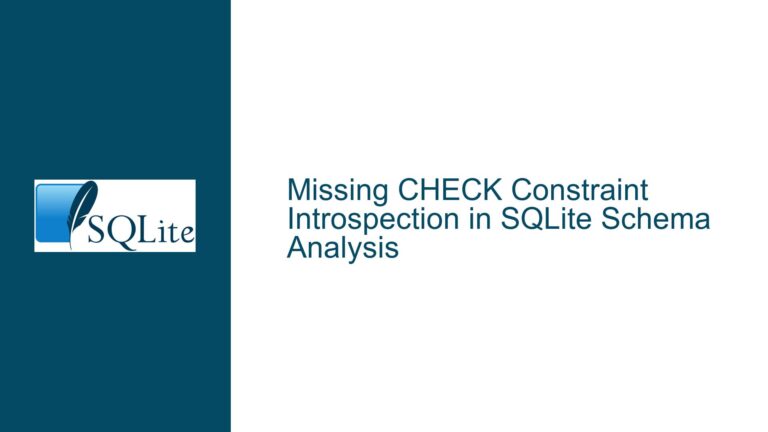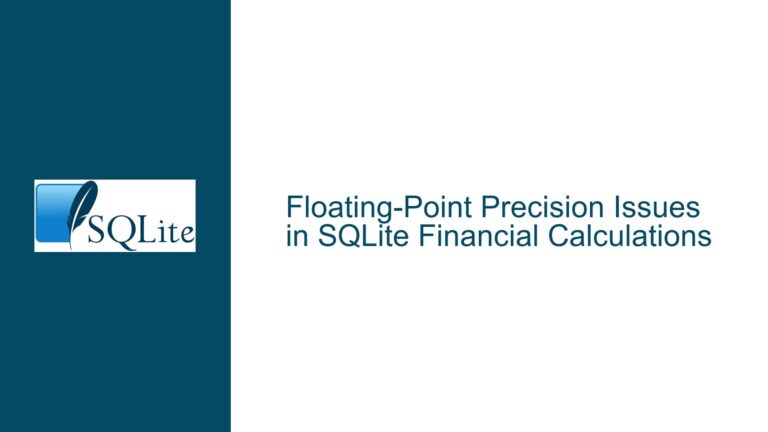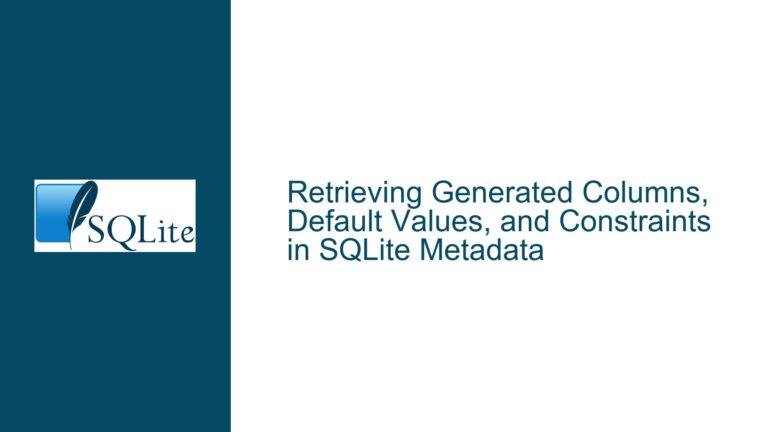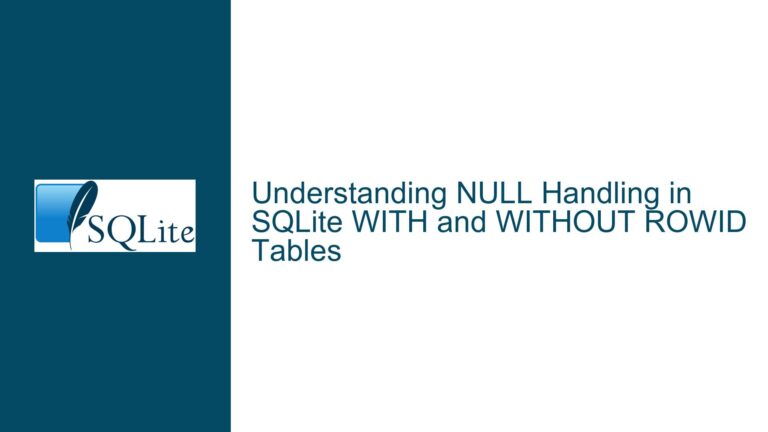Determining If Numeric SQLite Columns Represent Datetimes Without Schema Metadata
Understanding Column Intent in SQLite When Handling Numeric DateTime Representations
Core Challenge: Dynamic Type Inference for DateTime Values in Numeric Columns
The central challenge arises when an application executes arbitrary SQL queries against SQLite databases with no prior knowledge of the schema. Columns declared as INTEGER or REAL may store numeric values representing dates or times in formats like Unix epochs, Julian days, or custom epochs. The application must dynamically infer whether such values are temporal (requiring conversion to human-readable dates) or generic numbers. This problem is compounded by SQLite’s type affinity system, where column types are mere suggestions, not strict enforcers of data formats. Without explicit metadata or documentation, the application must rely on indirect methods to distinguish between numeric dates and ordinary numbers.
The complexity stems from three factors:
- Ambiguity in Numeric Representations: A value like
1641600000could represent a Unix timestamp (2022-01-08) or an unrelated integer (e.g., a transaction ID). - Diverse Epochs and Units: Temporal values may use epochs such as Unix (1970-01-01), Julian (4714 BCE), or custom epochs defined by legacy systems. Units vary (seconds, days, milliseconds).
- Lack of Universal Conventions: Schema designers might store dates as integers or floats without adhering to common standards, making automated detection unreliable.
This issue impacts applications that dynamically process query results, such as data visualization tools, report generators, or ORM layers. Misinterpreting a numeric column as a datetime (or vice versa) leads to incorrect displays, calculation errors, or silent data corruption.
Root Causes of Ambiguity in Numeric DateTime Detection
Cause 1: Absence of DateTime-Specific Metadata in SQLite
SQLite does not enforce strict data types or provide built-in metadata flags to indicate that a column stores temporal data. While DATETIME is a common type in other databases, SQLite treats all columns as having type affinity (e.g., INTEGER, REAL, TEXT). A column named timestamp with INTEGER affinity might store Unix time, but this is a naming convention, not a technical guarantee. Without explicit documentation or external schema descriptions, applications cannot definitively determine whether a numeric column represents a datetime.
Cause 2: Proliferation of Epoch Formats and Units
Even if an application assumes a numeric column contains a datetime, it must guess the epoch and unit. For example:
- Unix time uses seconds since 1970-01-01.
- Julian dates count days since noon on January 1, 4713 BCE.
- Microsoft’s OLE Automation dates use days since 1899-12-30 with fractional days for time.
- GPS time counts weeks since 1980-01-06, with additional second offsets.
Values may also be stored in non-standard units (e.g., milliseconds, minutes, or fortnights). A value of 18687.75 could represent 18687 days and 18 hours since the OLE epoch (2021-03-18 18:00:00) or 18,687.75 seconds (5 hours 11 minutes 27.75 seconds) since an arbitrary event.
Cause 3: Schema Design Inconsistencies
Legacy systems or ad-hoc databases often lack documentation, and developers might use numeric columns for dates without consistency. For instance, one table might store Unix timestamps in an INTEGER column named created, while another uses a REAL column event_time for Julian dates. Without centralized governance, these inconsistencies make automated detection impractical.
Strategies for Detecting and Handling Numeric DateTime Values
Step 1: Leverage Column Names and Schema Metadata
While SQLite does not enforce temporal types, schema introspection can provide clues:
- Column Naming Conventions: Columns named
date,timestamp, or*_at(e.g.,created_at) are more likely to store temporal values. - Foreign Key Relationships: A column referencing a
datetimecolumn in another table might share the same format. - Comments and Documentation: If the database includes schema comments (via
CREATE TABLEstatements or external docs), parse them for hints like-- Epoch: Unix (seconds since 1970).
Implementation Example:
-- Extract column names and types for a given table
SELECT name, type FROM pragma_table_info('table_name');
If a column named modified_time has type INTEGER, prioritize checking for common epochs.
Step 2: Apply Heuristic Range Checks
Numeric dates often fall within predictable ranges. For example:
- Unix Timestamps (seconds): Current values (2023) are ~1.6–1.7 billion. Values below 1 billion predate 2001-09-09.
- Julian Dates: Values start at 0 in 4713 BCE. Modern dates are ~2.4 million (e.g., 2023-10-10 ≈ 2,460,233).
- OLE Automation Dates: Days since 1899-12-30. 2023-10-10 ≈ 45,243 days.
Algorithm:
- For an
INTEGERvalueV:- If
Vis between 1.6e9 and 2e9, test Unix epoch conversion. - If
Vis between 2.4e6 and 2.5e6, test Julian date conversion.
- If
- For a
REALvalueV:- If
Vis between 40,000 and 50,000, test OLE date conversion. - If
Vhas a fractional part, check if it represents time (e.g., 0.5 = 12:00:00).
- If
Limitations:
- Legacy systems might use non-standard epochs (e.g., days since 1904-01-01 in Excel for Mac).
- Range checks produce false positives (e.g., large IDs mistaken for Unix timestamps).
Step 3: Support Configurable Epoch and Unit Overrides
When heuristics fail, allow users to specify the epoch and unit for specific columns. This is critical for legacy systems with custom epochs.
Configuration Example (JSON):
{
"tables": {
"events": {
"columns": {
"event_date": {
"epoch": "1899-12-30",
"unit": "days"
}
}
}
}
}
Implementation Steps:
- Parse the configuration to map columns to epochs and units.
- Apply conversions dynamically using SQLite’s
datetimefunction:SELECT datetime(event_date / 86400 + (strftime('%s', '1970-01-01') - strftime('%s', '1899-12-30')) / 86400.0), 'unixepoch') FROM events;
Step 4: Cross-Validate with Adjacent Temporal Data
If a numeric column is suspected to be a datetime, compare it with known date columns in the same table. For example:
- If
created_atis aTEXTISO date andcreated_epochis anINTEGER, verify thatcreated_epochmatches the Unix timestamp ofcreated_at. - Use SQL window functions to check for temporal consistency (e.g., ascending order correlating with
TEXTdates).
Query Example:
WITH converted AS (
SELECT
created_at,
datetime(created_epoch, 'unixepoch') AS converted_date
FROM events
)
SELECT COUNT(*)
FROM converted
WHERE created_at != converted_date;
A low mismatch count suggests created_epoch is a valid Unix timestamp.
Step 5: Fallback to User Interaction or Logging
When automated detection is uncertain:
- Prompt Users: Present both numeric and converted datetime values and let users choose.
- Log Uncertain Conversions: Flag ambiguous columns for later review.
Example Workflow:
def convert_value(value, column_name):
# Heuristic checks
if is_likely_unix(value):
converted = datetime.utcfromtimestamp(value)
logging.info(f"Converted {column_name}={value} to {converted}")
return converted
else:
logging.warning(f"Ambiguous numeric value in {column_name}={value}")
return value
Step 6: Adopt Schema Annotations or External Metadata
For long-term reliability, advocate for schema annotations (e.g., SQLite extensions or companion files) that specify temporal columns.
Example Annotation Table:
CREATE TABLE column_metadata (
table_name TEXT,
column_name TEXT,
data_type TEXT,
epoch TEXT,
unit TEXT
);
INSERT INTO column_metadata VALUES ('events', 'event_time', 'INTEGER', 'unix', 'seconds');
Query with Annotations:
SELECT
e.*,
datetime(e.event_time, 'unixepoch') AS event_datetime
FROM events e
JOIN column_metadata m
ON m.table_name = 'events' AND m.column_name = 'event_time';
Final Recommendations
- Prefer Explicit Temporal Types: Encourage schema designers to use
TEXTfor ISO-8601 dates or add metadata tables. - Document Epochs and Units: Maintain a data dictionary describing temporal columns.
- Combine Heuristics and Configuration: Use automated checks as a first pass, but allow overrides for edge cases.
- Validate with Data Profiling: Periodically audit numeric columns for temporal consistency using range analysis and outlier detection.
By integrating these strategies, applications can mitigate the risks of misinterpreting numeric date-time values while accommodating the flexibility and quirks inherent in SQLite’s type system.
